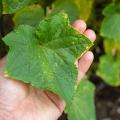Whitefly-transmitted Viruses in Cucurbit Crops
Survey of Whitefly-transmitted Viruses in Watermelon and Other Cucurbit Crops in Alabama, Louisiana, and Mississippi
.jpg)
Photo: Chlorosis on leaves near the crown is visible down the center of rows in a melon field in California with plants infected with both cucurbit chlorotic yellows virus and cucurbit yellow stunting disorder virus. Credit: W. M. Wintermantel, USDA-ARS.
Project Summary: A number of whitefly-transmitted viruses, including cucurbit leaf crumple virus (CuLCrV), cucurbit yellow stunting disorder virus (CYSDV), cucurbit chlorotic yellows virus (CCYV), and squash vein yellowing virus (SqVYV), are able to infect and cause losses in melons and other cucurbit crops. These and other insect-transmitted viruses, which cause similar yellowing symptoms, are known to occur in the larger melon- and watermelon-producing states. Appropriately, research on these viruses has been largely focused on those states. However, natural and manmade activities may lead not only to the introduction of viruses to new areas but also to the expansion of the current georgraphic range of viruses. This is evidenced by the recent spread of cucurbit viruses between California and Florida and from Florida into Georgia and South Carolina. The threat these viruses pose to melon and watermelon production extends to watermelon production in all watermelon-producing states, and the current status of these viruses in states that have not been the focus of research is deserving of exploration, particularly for the benefit of watermelon and other cucurbit producers. The purpose of this project was to determine the occurrence of the major whitefly-transmitted viruses known to infect cucurbits in the Central Gulf Coast states of Alabama, Louisiana, and Mississippi and to educate watermelon and other cucurbit growers and stakeholders on the importance, recognition, and management of these viruses. This was accomplished through a collaborative effort between plant pathologists at the USDA-ARS, Auburn University, Louisiana State University, and Mississippi State University. Samples of watermelon and other cucurbit crops collected during field surveys conducted in Alabama, Louisiana, and Mississippi from 2020 to 2022 were tested for the presence of the known whitefly-transmitted viruses affecting watermelon and other cucurbits in the U.S. Viruses were identified using established molecular detection systems involving multiplex RT-PCR and PCR to amplify specific nucleic acid sequences unique to each virus and gel electrophoresis to visualize amplified products, which allows for the identification and differentiation of the target viruses present in a sample. Project collaborators developed educational resources (linked below) and held an online training (video below) to educate watermelon growers and stakeholders on the known whitefly-transmitted viruses affecting watermelon and other cucurbits in the U.S. Data from the survey is currently being analyzed.
Training Video/Presentation:
Factsheet: Whitefly-transmitted and Yellowing Viruses in Watermelon and Other Cucurbit Crops
Photo Guide: A Photo Guide to Whitefly-transmitted and Yellowing Viruses in Watermelon and Other Cucurbit Crops
Project Collaborators:
- Dr. Rebecca A. Melanson (State Project Leader - Mississippi)
Mississippi State University Extension Service
(601) 857-2284
- Dr. Edward Sikora (State Project Lead - Alabama)
Alabama Cooperative Extension System - Auburn University
(334) 332-7433
- Dr. Rajghuwinder (Raj) Singh (State Project Lead - Louisiana)
Louisiana State University Agricultural Center
(225) 578-4562
- Dr. William M. Wintermantel (Project Leader)
USDA-ARS
Acknowledgement: This project was funded by the National Watermelon Association. Any opinions or recommendations expressed on this webpage do not necessarily reflect the views of the National Watermelon Association.
Publications
News
RAYMOND, Miss. -- Mississippi State University Extension Service plant pathologist Rebecca Melanson was recently recognized for her work to further the development and implementation of integrated pest management in the cucurbit industry. The Emerging Viruses in Cucurbits Working Group, or EVCWG, received the 2024 Friends of IPM Pulling Together Award. Melanson and Bill Wintermantel, a scientist with the U.S. Department of Agriculture, Agricultural Research Service, co-chair the group that was established in 2022.
Did you know the Mississippi State University Extension Service has a laboratory that is designated to diagnose plant diseases and nematodes? Yes, it does! Learn how the Mississippi State University Extension Service Plant Diagnostic Laboratory and its scientists protect the crops that provide our food and fiber along with other home and garden crops.
RAYMOND, Miss. -- Commercial vegetable growers have a new mobile-based resource to help them manage pests and diseases in their crops. The MyIPM for Vegetables app is the latest in the MyIPM app series. MyIPM for Vegetables currently offers resources for tomatoes and cucurbits, which includes cucumbers, pumpkins, squash and watermelons.





